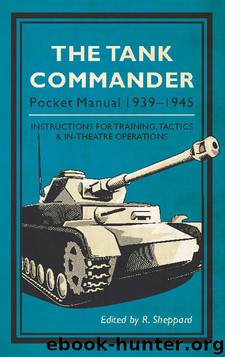The Tank Commander Pocket Manual: 1939-1945 by R. Sheppard

Author:R. Sheppard [Sheppard, R.]
Language: eng
Format: azw3
Publisher: Pool of London Press
Published: 2016-08-19T04:00:00+00:00
CHAPTER 3: IN THEATRE
For tankers, battles often only lasted a few hours; the vast majority of their time was spent on the move, observing, mounting guard, refuelling, carrying out maintenance, training, camouflaging the tank, and finally, after all else was done, cooking, eating, and resting.
As well as their weapon and protection in battle, the tank was the crew’s home and shelter. Crews could be very attached to their tank, referring to it by name, though some crews clearly had a love-hate relationship with their mount. Love or hate, tanks had to be carefully tended. The driver would spend most of his spare time tinkering and checking the engine. Nobody would have begrudged him that, as they were all dependent on the tank’s mobility in battle. As it was rather crudely put in rather crudely put in Instruction Book Driving and Maintenance. Tanks Infantry Matilda I, II, III, IV, V: ‘Remember, if your tank becomes immobile, your troop has lost one-third of its fire power - a stationary object is a much easier target than a moving one - do not, by sheer neglect of your periodical maintenance, murder your pals in your crew. Any person can take a tank into battle, but it takes an experienced driver, one who has maintained his vehicle perfectly, to bring it out. …Nurse your tank as you would your horse. On reaching the bivouac area feed it with fuel, oil and water … groom it and lubricate it before you feed and groom yourself - have it always ready to move at a moment’s notice.’
Of course the maintenance of a Matilda, or any tank, could not be completed by the driver alone; in the same manual are listed the jobs allocated to each member of the crew. The tank commander had 22 specific checks to be carried out before duty, his crew each had more. The wireless operator would have ensured the wireless was in working order. The gun barrel needed cleaning on a daily basis, which required several men. Throwing a track was a constant worry, so good crews would have checked the tracks whenever they could. Repairs would have been carried out by the crew if at all possible. The tank commander would have recorded and reported on completed maintenance. He would be the one to ensure maintenance was carried out despite bad weather or in difficult conditions, and he kept an eye out for conditions that might cause problems for the tank, for example river crossings could wash the grease out of fittings, and rubber gaskets might perish in the cold, leading to leaks.
This ‘short’ service manual for the Russian T-34 dates to 1942. It notably does not include the regular maintenance necessary for the tank’s weapons, which would have been detailed in the manuals for the individual weapons. Additional checks would be completed after a certain number of miles had been covered or the engine had run for a certain number of hours.
Download
This site does not store any files on its server. We only index and link to content provided by other sites. Please contact the content providers to delete copyright contents if any and email us, we'll remove relevant links or contents immediately.
| Africa | Americas |
| Arctic & Antarctica | Asia |
| Australia & Oceania | Europe |
| Middle East | Russia |
| United States | World |
| Ancient Civilizations | Military |
| Historical Study & Educational Resources |
The Radium Girls by Kate Moore(11642)
100 Deadly Skills by Clint Emerson(4702)
The Templars by Dan Jones(4561)
Rise and Kill First by Ronen Bergman(4554)
The Doomsday Machine by Daniel Ellsberg(4254)
The Rape of Nanking by Iris Chang(4028)
Killing England by Bill O'Reilly(3901)
Hitler in Los Angeles by Steven J. Ross(3803)
Stalin by Stephen Kotkin(3732)
12 Strong by Doug Stanton(3423)
Hitler's Monsters by Eric Kurlander(3174)
Blood and Sand by Alex Von Tunzelmann(3062)
Darkest Hour by Anthony McCarten(3019)
The Code Book by Simon Singh(2876)
The Art of War Visualized by Jessica Hagy(2846)
Hitler's Flying Saucers: A Guide to German Flying Discs of the Second World War by Stevens Henry(2631)
Babylon's Ark by Lawrence Anthony(2438)
The Second World Wars by Victor Davis Hanson(2423)
Tobruk by Peter Fitzsimons(2380)
